Unit 5 Our School
- 格式:ppt
- 大小:1.53 MB
- 文档页数:10
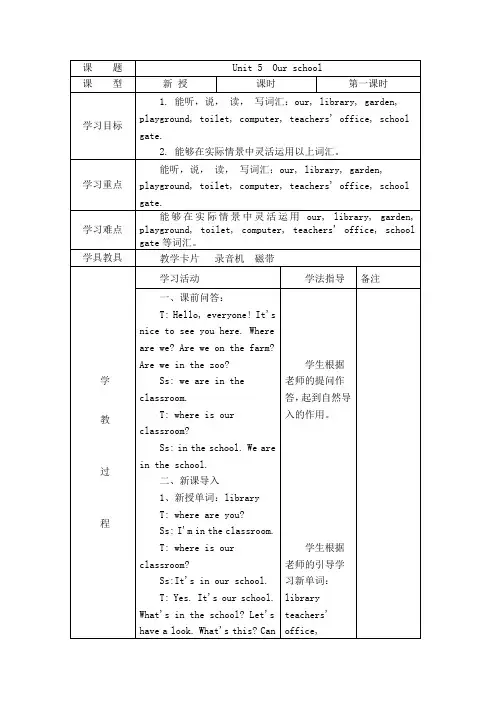
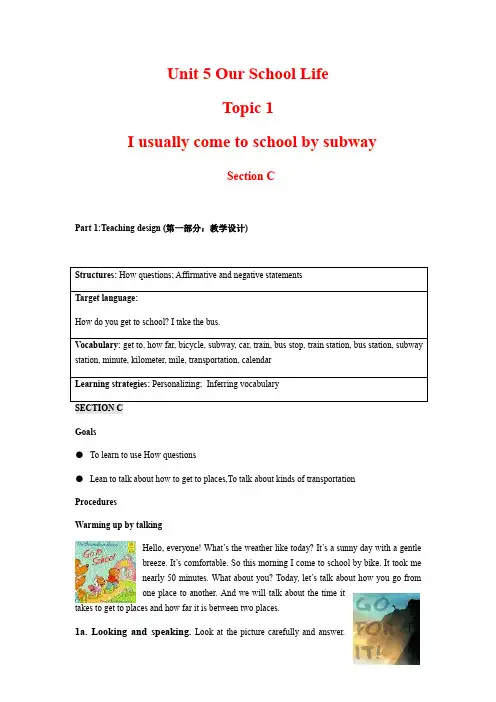
Unit 5 Our School LifeTopic 1I usually come to school by subwaySection CPart 1:Teaching design (第一部分:教学设计)Structures: How questions; Affirmative and negative statementsTarget language:How do you get to school? I take the bus.Vocabulary: get to, how far, bicycle, subway, car, train, bus stop, train station, bus station, subway station, minute, kilometer, mile, transportation, calendarLearning strategies: Personalizing; I nferring vocabularySECTION CGoals●To learn to use How questions●Lean to talk about how to get to places,To talk about kinds of transportationProceduresWarming up by talkingHello, everyone! What’s the weather like today? It’s a sunny day with a gentlebreeze. It’s comfortable. So this morning I come to school by bike. It took menearly 50 minutes. What about you? Today, let’s talk about how you go fromone place to another. And we will talk about the time ittakes to get to places and how far it is between two places.1a. Looking and speaking.Look at the picture carefully and answer.Then please write how the students in the picture get to school in the morning in the chart.Sample answers:1. take the subway2. ride a bike3. take the bus4. take the train5. walk(on foot)6. take a boat7. take a taxi 8. go in a parent’s carAnswers:1. Bob takes the train.2. Mary takes the subway.3. John takes the bus.4. Paul walks.5. Yang Lan walks.TapescriptA: How do Bob and Mary get to school?B: Bob takes the train and Mary takes the subway.A: How does John get to school?B: He takes the bus.A: How do Paul and Yang Lan get to school?B: They walk. Look, there they are waling now!Now read the tapescript, shadow the how questions and underling the expressions.1b.Read and understand.Task 1.Fast readingwhat's the best title of the passage?A.How does Jane go to school?B.Jane's morningC.Jane's dayD.Jane's homeTask2.Careful reading.(1)When do the classes begin?(2)How many classes does she have in the morning?(3)Where does she have lunch?(4)When does she play soccer with her classmates?1C. Doing pairworkLook at the pictures. Can you name each form of transportation? They are easy to you. Read the time and distance that goes with each form of transportation. Pay attention to “mile”, which is a common measure of distance in some western countries. (1 mile=1.6 kilometers).Read the example dialogue in the box.Now make your own conversations using the information in the picture with your partner.A: How do you get to school?B: I take the train.A: How long does it take you to get from home toSchool ?B: It takes 35 minutes.A: How do you get to school?B: I walk.A: How long does it take you to get from home to school ?B: It takes 40 minutes.A: How do you get to school?B: I take the bus.A: How long does it take you to get from home to school?B: It takes 15 minutes.OK. Stop here please. Let’s ask some pairs to say their dialogues.1d. Talking and writingWell done everyone! Now let’s play a game: Info Gap Race! This time you work in groups of three. You decide which one is A, which one is B and which one is C. Please read the instruction. You ask each other questions to learn information for your chart, and then write the answers on the chart in your book. Don’t look at others’ pages please. The first group to fill in all the blanks is the champion.Sample dialogue:。
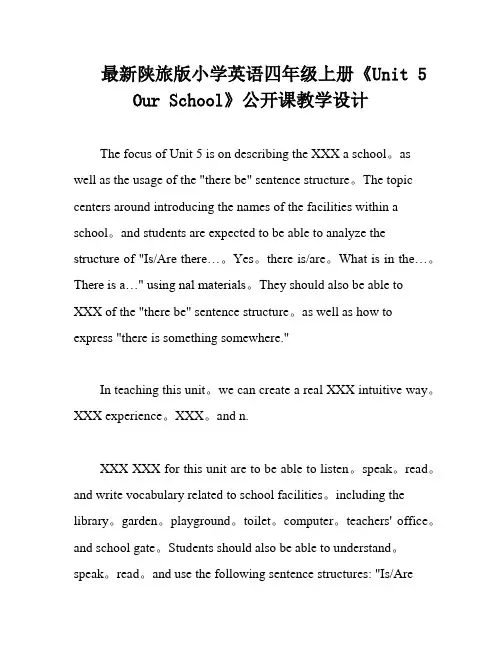
最新陕旅版小学英语四年级上册《Unit 5 Our School》公开课教学设计The focus of Unit 5 is on describing the XXX a school。
as well as the usage of the "there be" sentence structure。
The topic centers around introducing the names of the facilities within a school。
and students are expected to be able to analyze the structure of "Is/Are there…。
Yes。
there is/are。
What is in the…。
There is a…" using nal materials。
They should also be able toXXX of the "there be" sentence structure。
as well as how to express "there is something somewhere."In teaching this unit。
we can create a real XXX intuitive way。
XXX experience。
XXX。
and n.XXX XXX for this unit are to be able to listen。
speak。
read。
and write vocabulary related to school facilities。
including the library。
garden。
playground。
toilet。
computer。
teachers' office。
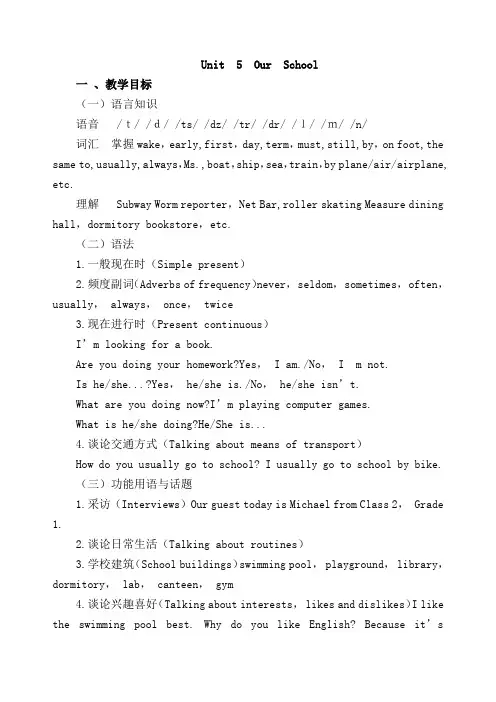
Unit 5 Our School一、教学目标(一)语言知识语音 /t/ /d/ /ts/ /dz/ /tr/ /dr/ /l/ /m/ /n/词汇掌握wake,early,first,day,term,must,still,by,on foot,the same to,usually,always,Ms.,boat,ship,sea,train,by plane/air/airplane, etc.理解 Subway Worm reporter,Net Bar,roller skating Measure dining hall,dormitory bookstore,etc.(二)语法1.一般现在时(Simple present)2.频度副词(Adverbs of frequency)never, seldom, sometimes, often,usually, always, once, twice3.现在进行时(Present continuous)I’m looking for a book.Are you doing your homework?Yes, I am./No,Is he/she...?Yes, he/she is./No,he/she isn’t.What are you doing now?I’m playing computer games.What is he/she doing?He/She is...4.谈论交通方式(Talking about means of transport)How do you usually go to school? I usually go to school by bike.(三)功能用语与话题1.采访(Interviews)Our guest today is Michael from Class 2, Grade1.2.谈论日常生活(Talking about routines)3.学校建筑(School buildings)swimming pool, playground, library,dormitory, lab, canteen, gym4.谈论兴趣喜好(Talking about interests, likes and dislikes)I like the swimming pool best. Why do you like English? Because it’sinteresting and easy.5.借物(Borrowing things)How long can I keep it? Two weeks.6.新闻(News)、海报(Poster)Attention, please! Here is the news.7.谈论学校活动、科目和时间表(Talking about school activities,subjects and timetable)8.谈论学校生活(Talking about school life)(四)能力培养听能听懂谈论校园生活中比较熟悉的话题,识别主题,获取主要信息。
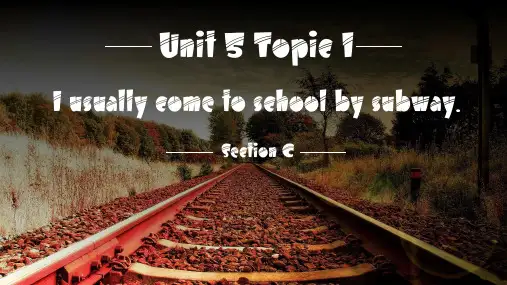
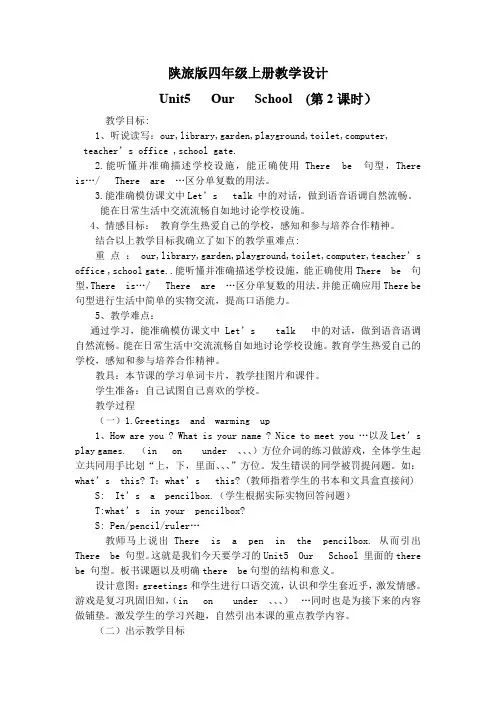
陕旅版四年级上册教学设计Unit5 Our School (第2课时)教学目标:1、听说读写:our,library,garden,playground,toilet,computer, teacher’s office ,school gate.2.能听懂并准确描述学校设施,能正确使用There be 句型,There is…/ There are …区分单复数的用法。
3.能准确模仿课文中Let’s talk 中的对话,做到语音语调自然流畅。
能在日常生活中交流流畅自如地讨论学校设施。
4、情感目标:教育学生热爱自己的学校,感知和参与培养合作精神。
结合以上教学目标我确立了如下的教学重难点:重点:our,library,garden,playground,toilet,computer,teacher’s office ,school gate..能听懂并准确描述学校设施,能正确使用There be 句型,There is…/ There are …区分单复数的用法。
并能正确应用There be 句型进行生活中简单的实物交流,提高口语能力。
5、教学难点:通过学习,能准确模仿课文中Let’s talk 中的对话,做到语音语调自然流畅。
能在日常生活中交流流畅自如地讨论学校设施。
教育学生热爱自己的学校,感知和参与培养合作精神。
教具:本节课的学习单词卡片,教学挂图片和课件。
学生准备:自己试图自己喜欢的学校。
教学过程(一)1.Greetings and warming up1、How are you ? What is your name ? Nice to meet you …以及Let’s play games. (in on under 、、、)方位介词的练习做游戏,全体学生起立共同用手比划“上,下,里面、、、”方位。
发生错误的同学被罚提问题。
如:what’s this? T:what’s this? (教师指着学生的书本和文具盒直接问) S: It’s a pencilbox.(学生根据实际实物回答问题)T:what’s in your pencilbox?S: Pen/pencil/ruler…教师马上说出There is a pen in the pencilbox. 从而引出There be 句型。
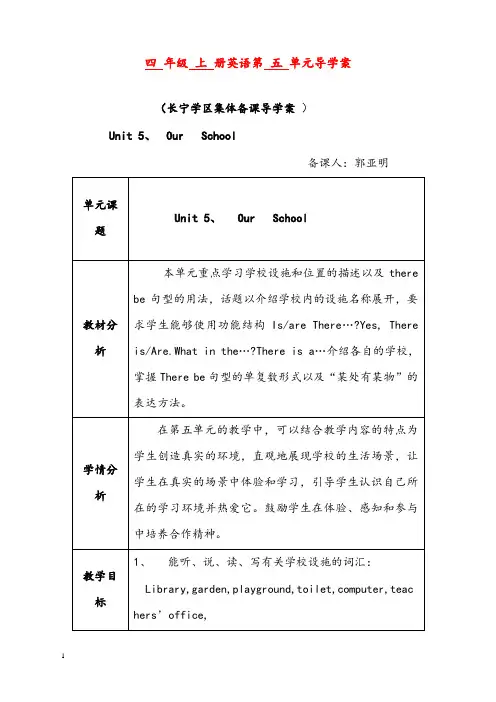
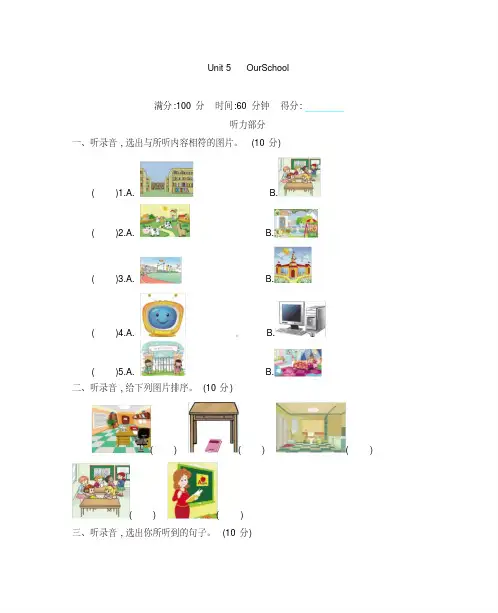
Unit 5 OurSchool满分:100分时间:60分钟得分:听力部分一、听录音,选出与所听内容相符的图片。
(10分)( )1.A. B.( )2.A. B.( )3.A. B.( )4.A. B.( )5.A. B.二、听录音,给下列图片排序。
(10分)( ) ( ) ( )( ) ( )三、听录音,选出你所听到的句子。
(10分)( )1.A.ThereisaTVintheteachers’office.B.Thereisa computerintheteachers’office.( )2.A.Thoseareclassrooms.B.Thosearebedrooms.( )3.A.Thereisaplaygroundinourschool.B.Thereisalibraryinourschool.( )4.A.What’sinyour classroom?B.What’sinyourbedroom?( )5.A.Arethereanylightsintheclassroom?B.Arethereanychairsintheclassroom?四、听录音,补全对话。
(10分)A:Look,Grandpa!Thisisour .B:Oh,it’sbeautiful.Istherea inyourschool?A:Yes,thereis.Andthere’sa inmyschool.B:It’swonderful.Arethereany inyour ?A:No,therearen’t.Butthere aremany and inmyclassroom.笔试部分五、英汉互译。
(10分)1.playground2.schoolgate3. 电脑4. 教师办公室5. 图书馆六、选择正确的答案。
(10分)( )1. arepens.A.ThatB.ThoseC.This( )2.There aballbehindthedoor.A.isB.areC.be( )3.There manypicturesonthewall.A.isB.areC.be( )4. nice!A.WhataB.WhatC.How( )5.What’syourschool?A.atB.inC.on七、判断下列句子与图片是(T)否(F)相符。
![[推荐精选]Unit 5 Our School Life知识学习总结要点总结(仁爱七下)](https://uimg.taocdn.com/e032210383c4bb4cf7ecd1c8.webp)
Unit 5 Our School Life知识点总结(仁爱七下)Unit5ourSchoolLifetopic1Howdoyougotoschool?一、重点词语:1.wakeup醒来,唤醒getup起床2.gotoschool去上学gohome回家3.godancing/shopping/skating/swimming去跳舞;购物、滑冰;游泳godoingsomething可用于表达去进行某种娱乐休闲活动。
4.表示交通方式:onfoot步行byboat坐船byship坐船byair乘飞机byplane乘飞机bytrain坐火车bysubway搭乘地铁bycar坐小汽车bybus坐公共汽车bybike骑自行车5.takethesubway/bus/car搭乘地铁;公共汽车;小汽车6.driveacartowork=gotoworkbycar驾车去上班takeabustowork=gotoworkbybus乘公共汽车去上班gotoschoolonfoot=walktoschool步行去上学7.rideabike/horse骑自行车;骑马8.afterschool/class放学以后;下课以后9.playthepiano/guitar/violin弹钢琴;吉他;小提琴playbasketball/soccer/football打篮球;踢足球;打橄榄球playcomputergames玩电脑游戏playwithacomputer玩电脑playsports做运动10.nextto紧挨着,在…旁边11.aplanofmyschool一幅我们学校的平面图12.onweekdays在工作日atweekends在周末13.havebreakfast/lunch/supper/dinner/meals吃早餐;中餐;晚餐;正餐;一日三餐haveclasses/lessons/ameeting上课;上课;开会14.watchTV/movies/games/theanimals看电视;电影;比赛;动物readnovels/newspapers/books看小说;报纸;书15.washone’sface/clothes洗脸;衣服16.反义词:up–down,early–late近义词:quickly–fastgetupearly早起belatefor迟到17.thefirst/second/third/fourthday第一;二;三;四天18.cleanthehouse打扫房子19.表示建筑物(尤其学校建筑物):ontheplayground在操场atschool/home/table在学校;家里;桌旁inacomputerroom/teachers’office/classroombuilding/gym/library/lab/canteen在电脑室;教师办公室;教学楼;体操馆;图书馆;实验室;食堂20.aroundsixo’clock=ataboutsixo’clock大约在六点21.频率副词:never,seldom,sometimes,often,usually,always二、重点句型:1.It’stimetogetup.该起床的时候了。
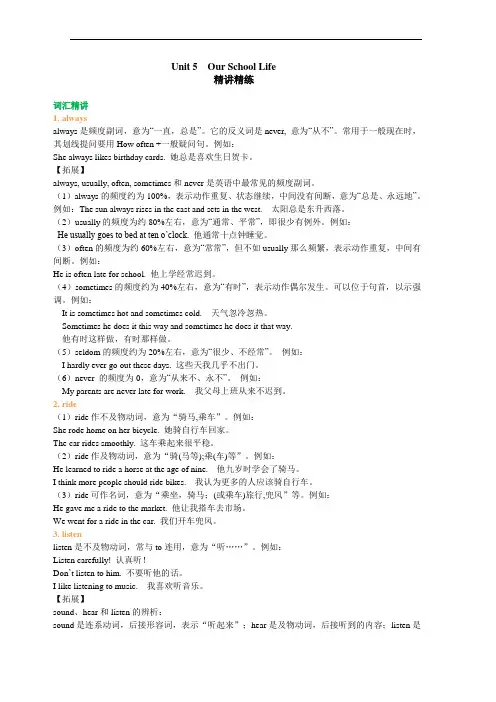
Unit 5 Our School Life精讲精练词汇精讲1. alwaysalways是频度副词,意为“一直,总是”。
它的反义词是never, 意为“从不”。
常用于一般现在时,其划线提问要用How often +一般疑问句。
例如:She always likes birthday cards. 她总是喜欢生日贺卡。
【拓展】always, usually, often, sometimes和never是英语中最常见的频度副词。
(1)always的频度约为100%,表示动作重复、状态继续,中间没有间断,意为“总是、永远地”。
例如:The sun always rises in the east and sets in the west. 太阳总是东升西落。
(2)usually的频度为约80%左右,意为“通常、平常”,即很少有例外。
例如:He usually goes to bed at ten o’clock. 他通常十点钟睡觉。
(3)often的频度为约60%左右,意为“常常”,但不如usually那么频繁,表示动作重复,中间有间断。
例如:He is often late for school. 他上学经常迟到。
(4)sometimes的频度约为40%左右,意为“有时”,表示动作偶尔发生。
可以位于句首,以示强调。
例如:It is sometimes hot and sometimes cold. 天气忽冷忽热。
Sometimes he does it this way and sometimes he does it that way.他有时这样做,有时那样做。
(5)seldom的频度约为20%左右,意为“很少、不经常”。
例如:I hardly ever go out these days. 这些天我几乎不出门。
(6)never 的频度为0,意为“从来不、永不”。
例如:My parents are never late for work. 我父母上班从来不迟到。
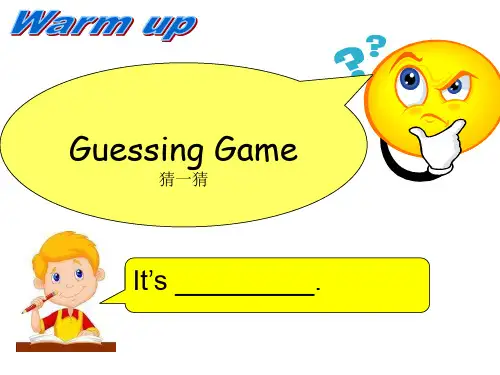
Unit 5 OurSchool一、核心词汇1.名词library 图书馆garden 花园playground 操场toilet 洗手间computer 电脑office 办公室gate 大门;门口2.代词our 我们的3.短语teachers office 教师办公室schoolgate 学校大门ofcourse 一定;当然二、拓展词汇常见公共场所park 公园gym 体育馆cinema 电影院theatre 剧院zoo 动物园restaurant 饭店hotel 旅馆三、核心句型1.Thoseareourclassrooms. 那些是我们的教室。
Thisisourschoolgate. 这是我们的校门。
解读:这是介绍那些是某物及这是某物的句型,those是指示代词that的复数形式。
举一反三:Thosearehens. 那些是母鸡。
Thisisapen. 这是一支钢笔。
2. —Isthereateachers’office?这里有教师办公室吗?— Yes,thereis. 是的,有。
— Arethereanycomputersinthelibrary? 图书馆里有电脑吗?— No,therearen't. 不,没有。
解读:这是therebe句型的一般疑问句,be动词根据主语的单复数的变化而变化。
举一反三: — Isthereacomputerintheteachers' office?教师办公室里有电脑吗?— Yes,thereis. 是的,有。
— Arethereanycrayonsinyourpencilbox?你的铅笔盒里有一些蜡笔吗?— No,therearen't. 不,没有。
3.Thereisasmalllibrary. 这里有一个小的图书馆。
Therearesomedesksandchairs. 这里有一些桌子和椅子。
解读:这是therebe句型的肯定句形式,主要是说明某处有某物。